Part 2: Chapter One: Against All Odds
Chapter One: Against All Odds
January 1st, 1836
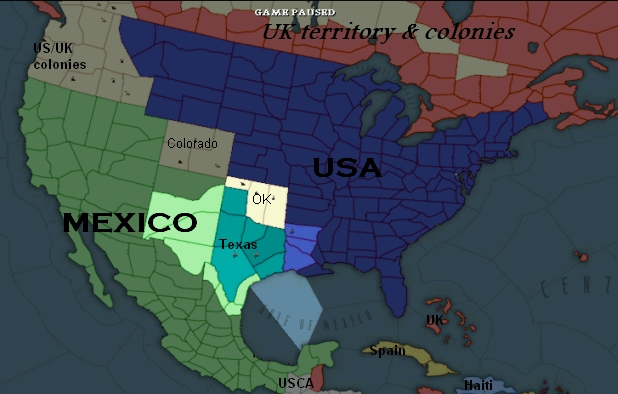
This is the current situation in North America. The Northwest terrotories is currently a mix of US and UK colonies. Colorado is split between Mexico and the US, and Oklahoma has 1 Texan colony and 2 US. The USCA is the United States of Central America, who are historically due to bloodily break apart within 15 years.
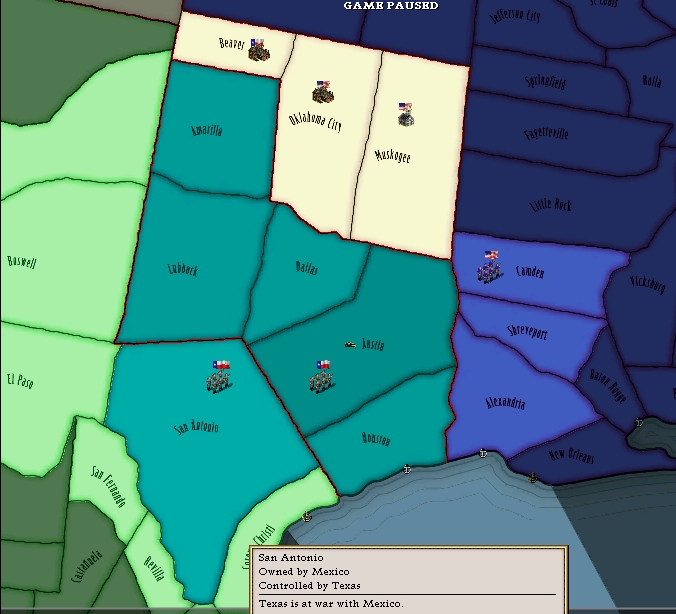
Texas currently owns Amarillo, Lubbock, Dallas, Austin, Houston and a trading post (a colonial building) at Beaver. San Antonio is under our control.
Texas is very young (just 12 days old, in fact), and is facing a seemingly impossible challenge: Mexico. We need to find a way to come out of this war intact, or at least survive it. First, a rundown of some basics:

The items in this bar are as follow: Manpower, Leadership, Research Points, the date, Prestige, Money, and Diplomats
Manpower is the amount of soldiers in reserves (that is, available to be recruited).
Leadership is accumulated over time, at a rate determined by the number of officers in your country. It is used to create generals or admirals, at a cost of 20 each.
Research Points are used for research. This is going to be zero for a while, because points are immediately fed into research as they are created. Research comes from education, which is set at the budget.
Prestige is a measure of how highly the rest of the world thinks of you. It slowly builds over time without any action, but there are numerous ways to add prestige points. Prestige is deducted when declaring war, losing a war, or going bankrupt. Prestige effects many things, such as priority at the world market for goods. Along with industrial and military scores, it determines the country's rank.
Money is in British pounds. 2000 is a lot for a country of the size and situation of Texas right now. 2000 is about how much the U.S. makes in a month or two though.
Diplomats are used to make diplomatic actions (such as proposing alliances, declaring wars, or offering deals). Some successful diplomatic actions will refund a diplomat. Rate of diplomat gain is influenced by the amount of a country's prestige, and doubled during war.
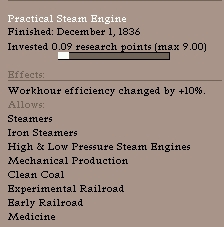
We've started researching Practical Steam Engine. Literacy in Texas is 50%, but I am currently funding education to the fullest so the research should be done in about a year. Right now this Industrial Tech will only provide a slight boost to my productivity; its main purpose will be to open me up to research that the US hasn't done yet, which I could then sell to them.

Our republic is has a rather small population, consisting mostly of soldiers, slaves and farmers. We are going to need many more people, and we are going to need to educate them. But there is currently a more pressing matter at hand.
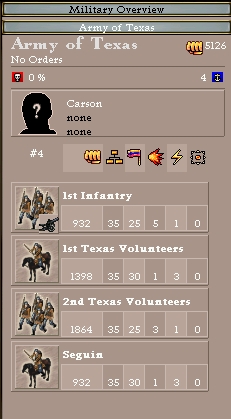
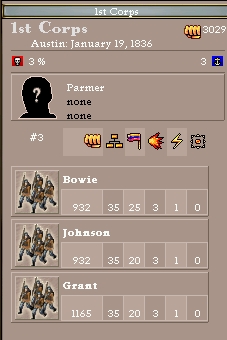
These are our two armies. The Army of Texas is stationed at Austin, the 1st Corps is garrisoned at San Antonio.
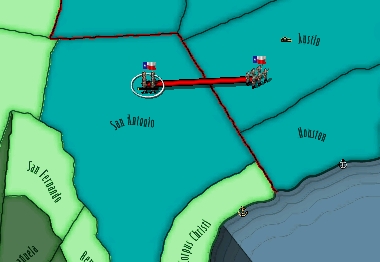
My first order is for the 1st Corps to fall back to Austin. I am going to merge the two armies, so that I may have one large force that can better fend off thousands of Mexican infantry.
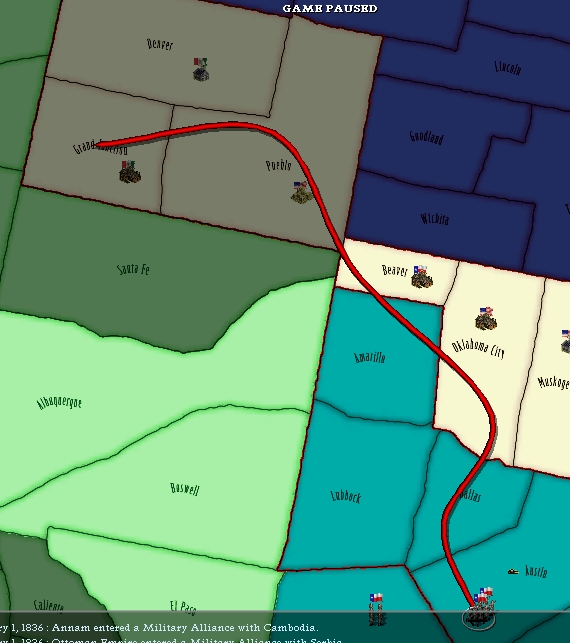
While the 1st Corps marches to Austin, I break the Seguin cavalry off from the Army of Texas and tell them to ride to Colorado to seize the Mexican colonies at Grand Junction and Denver.
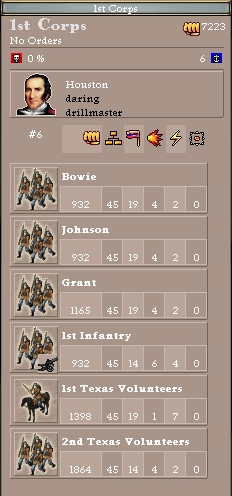
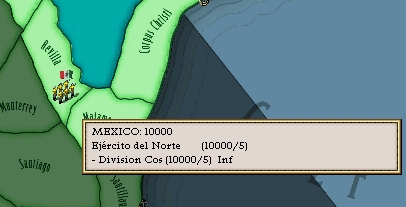
The 1st Corps arrives in Austin, is merged with the Army of Texas, and I spend my 20 leadership to put it under the command of General Sam Houston. Not a minute too soon either. Ten thousand Mexicans appear on the southern side of the Rio Grande.
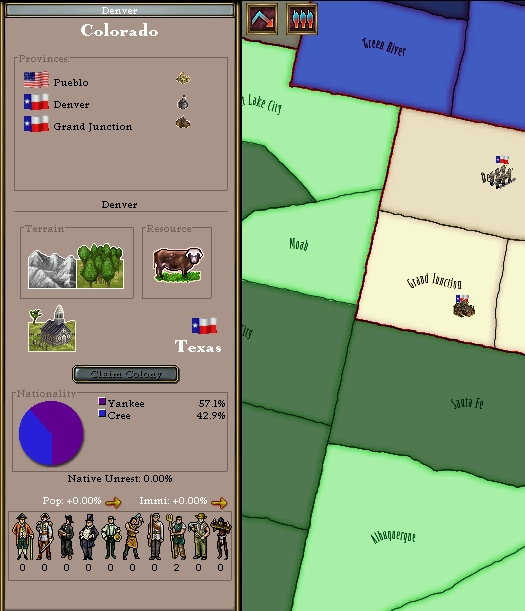
Not long afterwards, the Seguin cavalry have seized the Mexican colonies in Colorado. The population there is roughly half Yankee settlers and half Natives. The national cultures of Texas are Texan and Mexican, so if we were to formally annex Colorado these groups will be assimilated in time. However, Texas is a Protestant country, so while the Protestant Yankees would probably become Texan shortly, the pagan Cree would take much longer.
Now, we need to address the growing problem of the Mexican armies assembling to the South. They have taken back San Antonio and are heading toward Lubbock, Austin and Houston. And I have a solution.

Had a solution. A military alliance with the USA would pull them into this conflict, and Mexico cannot front the kind of numbers a mobilized USA can. I could hole up in Austin while Yank armies push the Mexican back.

However, despite not being the conflict, the USA is mobilizing itself. Perhaps it sees involvement in our situation inevitable.

And on August 4, the USA joins the war.
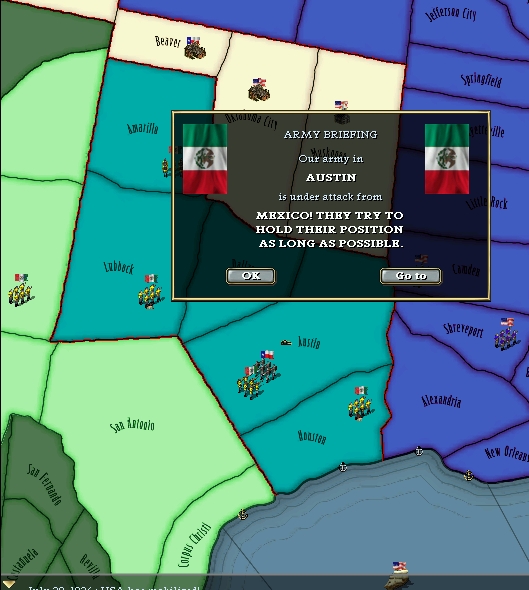
Are they too late though?

Nah. Houston's army should be able to hold out for a while in Austin, assuming Mexico doesn't send a completely absurd amount of troops in one attack.
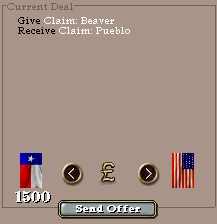
Envoys are sent to Washington to offer a deal. We will give them the trading post at Beaver for their fort at Pueblo, and we also ask for monetary support to the tune of 1500£. This would let them claim the area of Oklahoma, and us claim Colorado. We are also rather short on funds, so we need more money to fund the war.
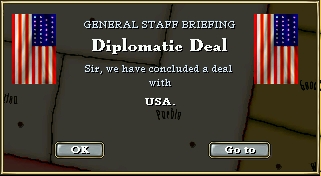
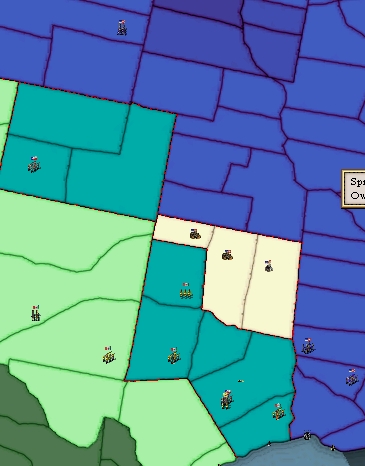
They accept, and the Colorado Territory is annexed into the Republic of Texas.
The Seguin Cavalry in Colorado are told to return to Texas proper, to assist in the defense of Austin. But they run into a Mexican division in the Oklahoma panhandle.
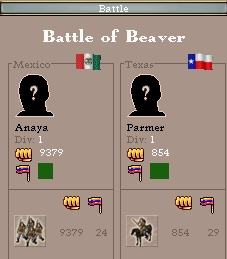
The Mexican leader Anaya's infantry outnumber the Seguin cavalry ten to one, so they retreat while they can and regroup in Wichita, Kansas. From their they are ordered to go further east then south to Austin, as to avoid any more invading Mexican divisions.
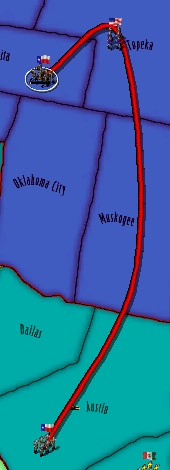
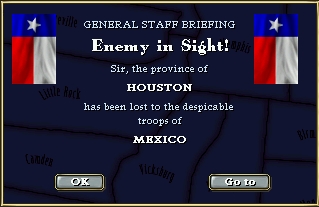
Dire news reaches us from Houston. On Oct 24 1836 it is officially in Mexican hands. The messenger also tells us that Lubbock had fell a few weeks before.

Nearly two months later, new reaches Austin that the U.S. has finally taken action in this war and invaded and seized northern Utah. We hope they decide to turn their attention to Texas soon.
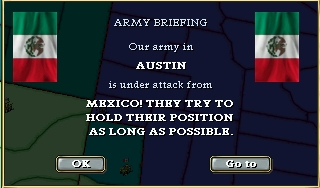
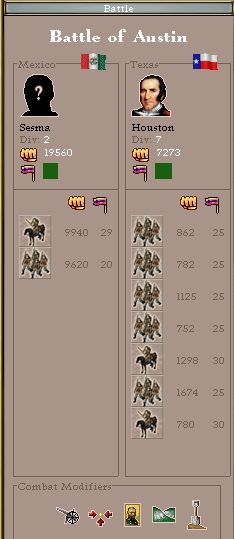

We are not sure how much longer Houston can hold out in Austin.
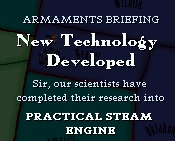
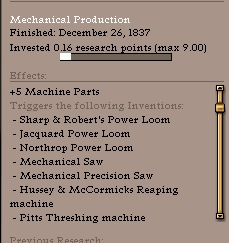
On January 27th of 1937, our researches complete the Practical Steam Engine and begin work on the concept of Mechanical Production. These techonologies are the groundwork for the industrial base we will need if we want Texas to be anything more than Mexico's punching bag in the future.

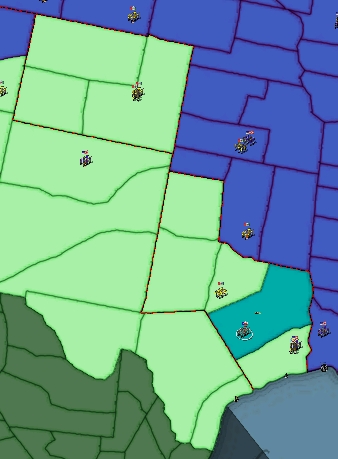
This isn't looking so great. Mexico controls all of Texas oustide of Austin. Mexican troops are bearing down on Austin from Dallas and the Mexicans have invaded Kansas, but the US is currently seiging Santa Fe and Houston.

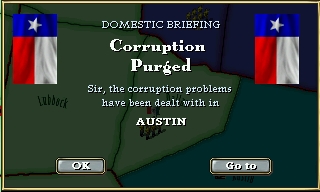
The US is making progress in New Mexico and Nevada and sending divisions from the east, but Mexico is still putting up a fight. They still hold Colorado and have invaded Wyoming. Also, it seems the corruption is Austin has gone away. I suppose they decided that maybe this just wasn't the best time.
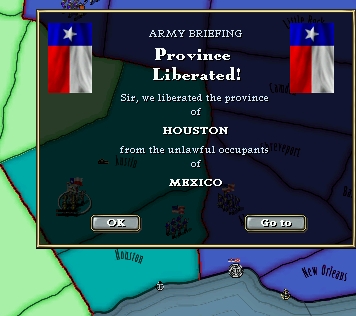
Good news at last. The Americans have retaken Houston.
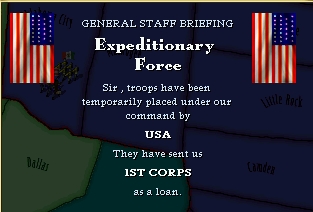
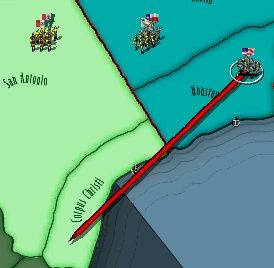
The US lends us the 1st Corps, the army that recaptured Houston. Though we cannot afford to pay their upkeep, we instruct them to head towards Corpus Christi before returning control.
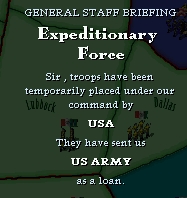
The US Army is sent as an expeditionary force. At first we were ecstatic, with thoughts of nearly a hundred thousand men at our command. However,
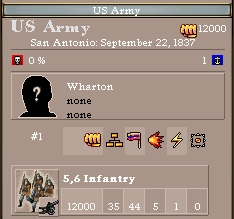
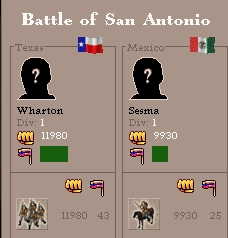
The "US Army" is a mere single division with an artillery brigade attached. They are sent to San Antonio, where they engage the enemy.
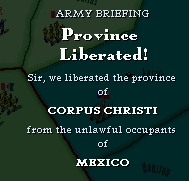
While the Battle of San Antonio continues, Corpus Christi is liberated.
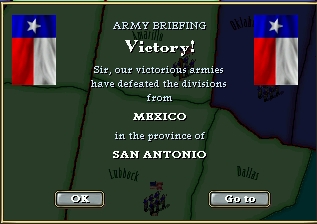
And on December 16, the we win the battle at San Antonio. Nearly another year has passed already. The Winter of 37 has proven fruitful so far for Texas, hopefully 1838 will see the Mexicans driven further south.
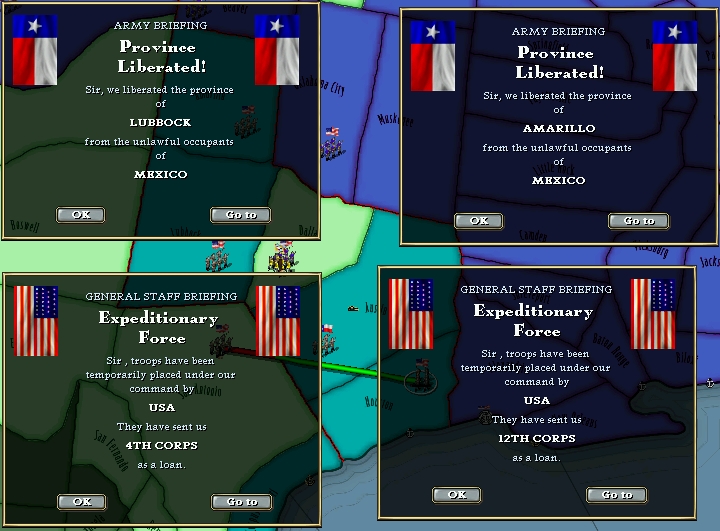
Wonderful news is brought on the 13th of January. At this rate American and Texan forces should be near the Rio Grande within a few months.
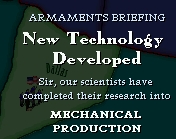
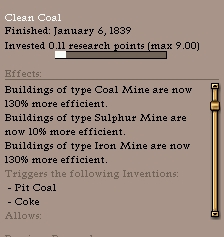
A week later, research on Mechanical Production is completed, and research is focused on Clean Coal. Clean Coal will slightly boost production at our sulphur mines, but will also provide a benefit in the future in another way.
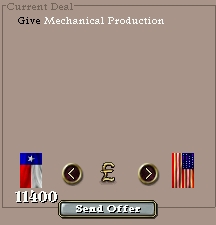

The US considers Texas kin, and is willing to support the Republic in its endeavours economically in exchange for Texan research. £11,400 is enough to keep us afloat for a while, but this does not come without a consequence. The rest of the world looks poorly upon the selling of research, and we lose 10 prestige.
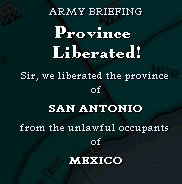
On February 18, San Antonio is freed. The rejoicing is cut short though.


Five days later, American troops returning home tell us the news: the US brokered a peace with Mexico. Outside of the seized colonies, there is no exchange of territory. Despite General Sam Houston's enraged, inebriated opposition and calls for an invasion of Mexico proper, the Texas Revolution is over, and the Lone Star Republic stands defiant.